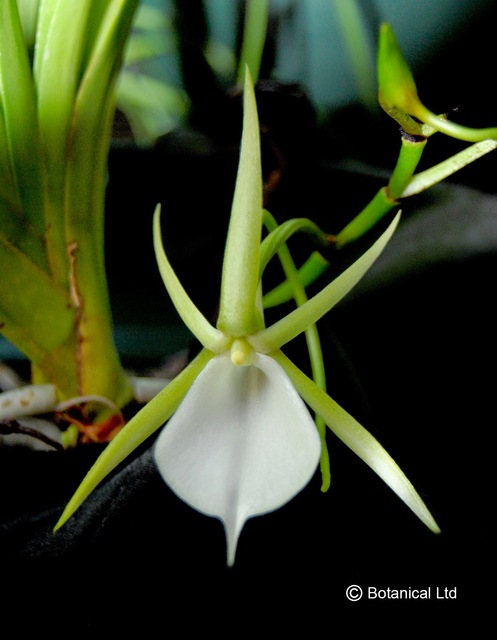This post is centered around two Angraecum praestans seedlings. The majority of former posts in this blog dealt strictly with the culture of first time bloomers or established plants. I thought it would be helpful to those beginners in understanding and seeing the progression and development of an individual species in culture. I stress so often that how I do things should be looked at as a starting point. You should do research prior to attempting to grow a particular orchid in your climate and growing conditions. What works for one may not work for another.
 Angraecum praestans seedlings
Angraecum praestans seedlings
 Natural habitat of Angcm. praestans is the western and northwestern areas of Madagascar. It is usually found growing as an epiphyte in dry woods. It has been found on cliffs and in smaller trees in sandy areas and in sand dunes.
Natural habitat of Angcm. praestans is the western and northwestern areas of Madagascar. It is usually found growing as an epiphyte in dry woods. It has been found on cliffs and in smaller trees in sandy areas and in sand dunes.
I chose Angcm. praestans because of the similar growing conditions here in South Florida compared to that in Madagascar. Keep in mind that the seasons are reversed because of the different hemispheres; the northern hemisphere's rainy season is the southern hemisphere's dry period and vice-verse. There is a period during the cooler months here in South Florida that temperatures may drop below the natural habitats extreme low of 57 degrees F (14C); those days are numbered between 6 and 12 days. The plants would be protected by either covering them or moving them into a warmer area.
Once these plants reach a mature height, the stems will be close to 12 inches (30cm) tall. As all Angraecums, leaves form opposite each other the length of the stem. They are arched with a leathery substance; they will be between 10 - 12 inches (25-30cm) long. New plants develop at the base of the plant and can start while the plant is still a seedling (as seen in the image below).

Angcm. praestans seedling with a new basal plant developing. -->
The seedlings were placed in terra cotta 3 inch (8cm) pots with numerous holes for faster drainage and for air movement. The material used for potting was a combination of medium sized charcoal and clay pellets (non-organic). This medium allows for fast drainage, air movement and space for the thick roots to grow freely (roots are about .25 inches (6mm) thick). When the plants eventually do mature in size, the present terra cotta pots will be cracked open carefully and set into larger pots with additional material being added around the broken pot and medium. As with any developing orchid, it is best to pot when the plant is actively growing; allowing the plant to establish itself quicker.

<-- These seedlings will be grown in these pots 2 - 3 years before being placed in either larger pots or baskets.
In it's natural habitat, Angcm. praestans grows as an epiphyte in dry woodlands, large bushes in sand dunes and cliffs not far from the coast. It is neither a large showy plant or a compact one. As stated earlier, it's stem will barely be 12 inches (30cm) high. Mounted plants seem to grow slower yet excel when the root system is exposed to moisture for a longer period of time being in a pot. It is imperative that the roots be allowed to breath and dry out some; using the proper size medium and making sure the air movement is strong enough will be similar to the plants requirements from its habitat.
Rainfall here in the northern hemisphere closely matches the seasonal rain amounts in the southern hemisphere. I start watering the plants every other day in early to mid April and will often water everyday when temperatures hold over 90 degrees (32 degrees C). The rain fall amounts peak in July through September as well as the temperatures being high. Late September rain starts to dramatically drop until the following spring. Watering is cut back to every three day as well as fertilizing being cut back. (If using water from a city water line, you should flush the medium with rain water or RO water to clear most of the salts.)
The blooming period usually begins late winter; prior to the rainy season. A well grown plant can produce 2 - 3 inflorescence with each producing 3 - 5 flowers. Blooms can be up to 4 inches (10cm) wide by 3 1/2 inches (9cm) long. Sepals and petals are greenish to yellowish in color while the lip is always white. The nectary ranges in length from 3 1/2 inches (9cm) to 5 inches (13.3cm) long and are usually greenish in color.
The amount of light the seedlings receive should be less than a mature plant; about 2,000 foot candles. Once the seedlings have been established in the pots for about a year, they will be moved into bright light (no direct sunlight), about 3,500 foot candles.
I use a balanced fertilizer every week and change that to every 10 -14 days during the cooler months. These seedlings will be treated with two systemic fungicides every three to four weeks. Alternating the fungicides every three months.
I will update this post every 4 - 6 months to show the development of the seedlings. A very special thank you to Sarah Wadddoups of the Angraecoid Alliance and to Brenda Oviatt of Botanica Ltd. for the use of their photographic images.
